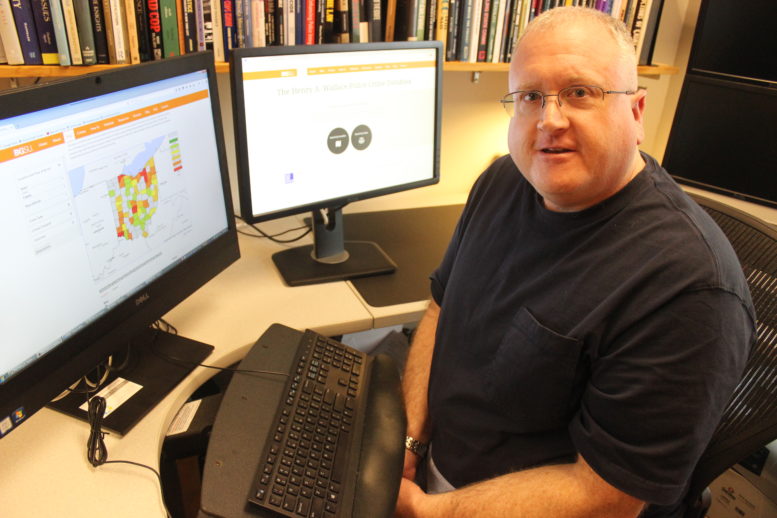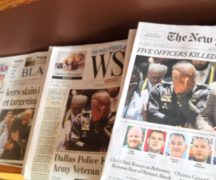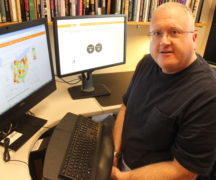By DAVID DUPONT
BG Independent News
As a researcher who studies misconduct by police, Phil Stinson has been in demand lately. NPR, the New York Times, CNN, BBC News, the Washington Post, and other news outlets have sought out his opinion on the killing of George Floyd by a Minneapolis police officer.
The killing sparked global outrage, and calls for changes in policing.
Stinson understands those pleas, but he’s not confident the calls to defund the police and other less extreme measures are likely to work.
“Some of that will be symbolic,” he told BG Independent News this week. “I don’t know that any meaningful reforms will come of that.”
The problem runs too deep.
“There’s a basic problem that many police officers across the country have a fear of black men and black boys and that fear is a core element of the police subculture,” Stinson said. “Police are socialized into their organizations. It’s a learned value, but it’s deeply rooted. It’s a core value of police subculture.”
He added: “And I don’t know how to deal with that and until we deal with that I don’t think reform efforts will be meaningful. I don’t think we can train our way out of it with a few implicit bias workshops.”
This doesn’t mean all police are racist. He’s not pointing a finger at individual officers. But too many, he said, have this fear. They approach their jobs as if they are warriors fighting a war, and if you’re at war there has to be an enemy. Ad that’s too often black men and boys.
Part of the problem is that in many places police do not live in the communities they patrol. Their children go to different schools, pray in different houses of worship, and shop in different stores.
Some initial findings, he said, show racial differences in the crimes officers commit against blacks and other ethnicities. They are more likely to be accused of violence assaults against African Americans.
The project initially did not code the race of victims, but started to do that.
The existence of videos of assaults, not additional scrutiny of the police, may be a factor in bringing to light those cases where the victims’ names become rallying cries.
Stinson noted that police officers shoot and kill about 1,000 people annually. Since 2005, though, only about 100 have been charged with murder or manslaughter.
The sustained outrage sparked by Floyd’s death seems to indicate maybe the country has reached a tipping point.
With people staying at home because of the pandemic, and distrust of government for that and other reasons rampant, it was “like a powder keg.”
While those factors played a part, Stinson said. “The horrific nature of the videos can’t be overstated.”
Stinson said some things seem to be making improvements.
He pointed to Camden, New Jersey, that abolished its police force and created another county law enforcement agency. Officers with histories of problems didn’t get hired by the new agency.
“They tried to instill a different set of core values in terms of community policing,” Stinson said. “It seems to have worked.”
Complaints are down including those alleging use of excess force. “Fewer officers seem to be getting into trouble.”
Still without addressing the systemic social problems including poverty, he said, it may very well regress.
Also, he said, “There are some functions that can’t be transferred to other agencies. If you’re a victim of a violent crime you ought to be able to seek assistance from the police.”
While some duties that fall to police can be done by social service agencies, those agencies are overtaxed by the drastic cuts in community health funding, Stinson said. “Deinstitutionalization has pushed many people with mental illness into the criminal justice system.”
Just getting rid of police, he said, is not realistic.
Like many of those protesting, Stinson questions the use of school resource officers. “It’s not clear what they are supposed to be doing,” he said. “It is clear that parents, teachers, school administrators feel safer. They have a reduced fear of crime with a school resource officer present.”
The concern is that routine school disciplinary issues become criminalized, rather than the problem being handled in school. This is especially true for students of color.
(BGSU professor Starr Keyes has studied this extensively.)
However, he added, the next time there is a shooting in a school with mass casualties that “will stop the hue and cry calling for the removal of school resource officers.”
Stinson and his team of nine research assistants have collected data on 17,000 cases of police being arrested for a crime since 2005, and they add 1,100 more each year.
Because there is no uniform reporting system they also cull information from media reports.
The work has continued through the pandemic while still maintaining security protocols.
The university’s Information Technology Services set up VPN access for the researchers. Stinson is allowed to return to his lab occasionally to scan new documents.
“We’re making forward progress, but it’s slowed us down and made it logistically far more complicated.”




